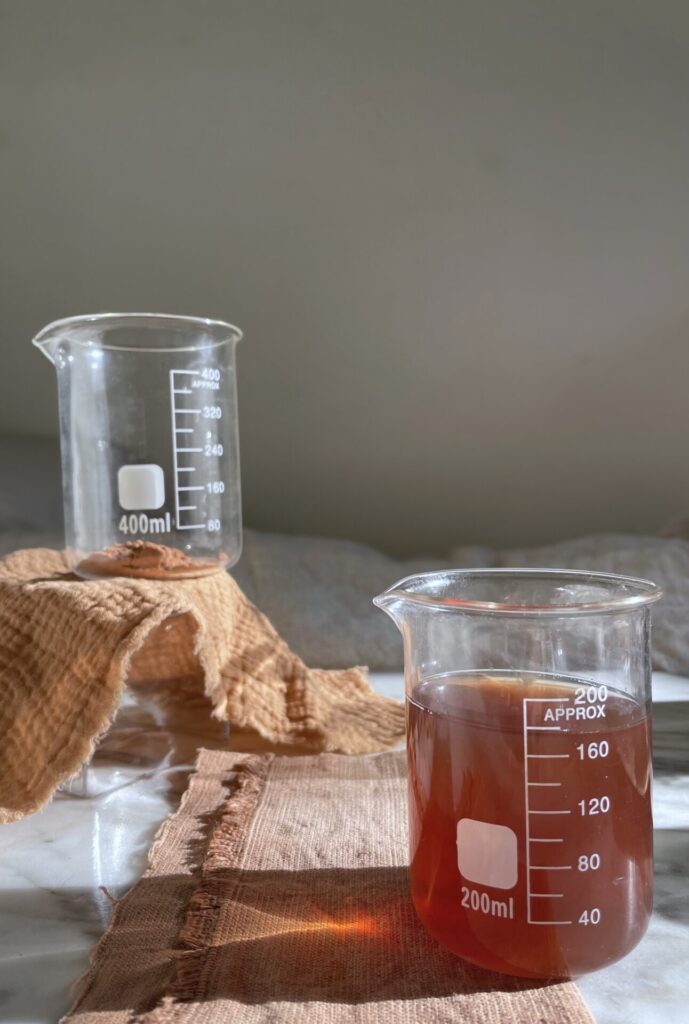
Mordanting with Tannin and Aluminum Sulfate is the traditional cellulose mordant and was widely used prior to the introduction of Aluminum Acetate or Aluminum Triformate. You may use Aluminum sulfate or Aluminum potassium sulfate. Both are commonly referred to as “alum”.
Our How To guides are intended to make the dye process easy, from scouring your fibers to dyeing with an assortment of dyes. You can find other How To guides here.
What is Mordanting?
Mordanting is the most important process of preparing fibers to accept color. Using a mordant helps to ensure the most durable and long-lasting colors. With the exception of indigo (as a vat dye, it does not require a mordant), this is not an optional step.
Mordanting provides the dyer flexibility as fibers can be mordanted in advance, dried, and dyed later, or mordanted and dyed in one day. Drying and storing, or “curing” alum-mordanted fibers often results in deeper shades on wool and silk. If you are new to natural dyeing, we recommend starting with wool fiber as it is the easiest to dye.
(Check out our Q & A: Round Up of Mordanting + Scouring 101 here.)

Mordanting with tannin and alum
Safety Information
Aluminum sulfate is easy to use with minimal odor or wafting powder and dissolves easily. However, we recommend wearing a dust mask or respirator, gloves, and an apron with all powders as they can be irritating to the nose, throat, and skin. We strongly recommend adult supervision if working with children.
We also recommend that you keep dye tools and utensils separate from kitchen tools and work with plenty of ventilation. Aluminum sulfate may be safely disposed in a municipal water system by pouring down the drain. Do not dispose of in waterways or drains that flow into waterways.
You will need
- Tannin extract
- Aluminum sulfate
- Soda ash
- Containers to dissolve the tannin, aluminum sulfate, and soda ash in
- Two buckets or dye pots to mordant in
- Dye rings (if dyeing skeins of yarn)
This is a room temperature procedure but you do need very hot water to dissolve the tannin and the alum.
Before you start, weigh the dry fibers you want to mordant. Write down the weight of the fiber (WOF), and calculate 10% tannin of that weight.
Weigh the tannin and dissolve it in a cup with very hot water. It will be a murky tan color. Add this to a larger container that will comfortably hold your fibers, like a small bucket.
Fill the bucket with enough water so that the goods can move easily in the liquid. Wet your fibers first, then add them to this container and gently submerge them, pressing out air bubbles.
Let the fiber remain in the tannin liquid for at least 1 hour and as long as overnight. Rotate the goods in the tannin bath occasionally, keeping them submerged. This tannin bath can be reused – keep it covered and labeled in between uses.
Next, calculate 12% aluminum sulfate on the WOF, and measure and dissolve the aluminum sulfate in a cup with very hot water. It will appear clear. Calculate and measure 1.5% soda ash on the WOF and dissolve separately. Carefully add both ingredients to a separate container that will comfortably hold your fibers. The mixture will bubble vigorously so make sure you have enough headspace in the container for the reaction.
Fill the container with enough room temperature water so that the goods can move easily in the liquid and mix well. Add the tannin-soaked fibers (do not rinse beforehand) and gently submerge them, pressing out air bubbles.
Let the fiber remain in the aluminum sulfate liquid for 2 hours, or as long as overnight. This aluminum sulfate bath can be reused – keep it covered and labeled in between uses.
Once the fibers are mordanted, you may remove them from the aluminum sulfate mordant bath and dye them.
Reusing the bath to save water and mordant
Reuse aluminum sulfate baths at least twice. If you observe cloudiness or flakes floating in the bath, it is time to change it. Recharge the bath with 50% of the amount of required mordant, or 1 teaspoon per 100 grams of fiber for a 5% solution, or 2 teaspoons for a 10% solution.
Storing mordanted fibers
You may leave the fibers in the mordant solution overnight, then extract excess water and proceed to dyeing. Mordanted fibers may be stored damp in a plastic bag and refrigerated for 3-5 days and cured or aged, as this also seems to increase the depth of shade in the dyed fibers. For longer storage, mordanted fibers may be air dried and stored for future use. Label and store your mordanted fiber and keep it away from dust or dye powders, as it is vulnerable to staining.
You might also like to read:
Q & A: Round Up of Mordanting + Scouring 101
Video of Live Q&A For (New Cold Water Mordant) Aluminum Triformate
Our weekly Mordant Monday series!
Shop:
Gallo Tannin
Aluminum Sulfate
Catharine Ellis and Joy Boutrup’s book, The Art and Science of Natural Dyes
